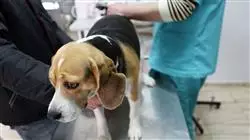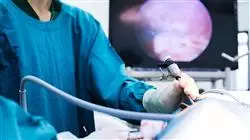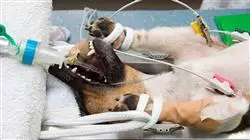University certificate
The world's largest faculty of veterinary medicine”
Description
Veterinarians must continue their education to adapt to new developments in this field”

Minimally Invasive Techniques for the Diagnosis and Treatment of various diseases in small animals were first implemented in veterinary medicine 20 years ago and have had exponential growth in the last decade.
This upturn, which goes hand in hand with the progress made by human medicine in the field, is owed to several factors: technical development, equipment and instruments that offer higher quality images and are more affordable; the development of specific diagnostic and therapeutic techniques, as well as of professionals who are better trained and carry out most of their clinical activities through these minimally invasive techniques, in addition to owners who are ever more concerned about the health of their pets and demand more specialized clinical services, more accurate clinical diagnoses and treatments that are less invasive and that will result in lower pain levels and fewer hospitalizations for their pets.
The teaching staff of this Postgraduate Diploma are at the forefront of the latest diagnostic techniques and treatment of diseases in small animals. Thanks to their specialized training, they have developed a useful and practical program that is adapted to the current reality, a reality that is becoming more and more demanding and specialized.
The teaching team has selected an agenda that generates specialized knowledge with an overview of the importance of minimally invasive techniques for the diagnosis and treatment of many diseases affecting small animals, in the description of equipment, instruments, approaches in minimally invasive surgery, anesthesia and most frequent complications.
It provides high-quality multimedia material on different surgical techniques, from the simplest and most common to the most technically complex.
As it is an online Postgraduate Diploma course, students are not restricted by set timetables, nor do they need to physically move to other locations. All of the content can be accessed at any time of the day, so you can balance your working or personal life with your academic life.
This training is the best option you can find to specialize in Diagnostic and Treatment Procedures for Minimally Invasive Surgery in Small Animals and make more accurate diagnoses”
This postgraduate diploma in Diagnosis and Minimally Invasive Surgical Treatment in Small Animals contains the most complete and up-to-date educational program on the market. The most important features of the program include:
- Case studies presented by experts in Minimally Invasive Veterinary Surgery in Small Animals
- The graphic, schematic, and practical contents with which they are created provide scientific and practical information on the disciplines, essential for professional development.
- Latest developments in Minimally Invasive Veterinary Surgery in Small Animals
- Practical exercises where self-assessment can be used to improve learning.
- Special emphasis on innovative methodologies in Minimally Invasive Veterinary Surgery in Small Animals
- Theoretical lessons, questions to the expert, debate forums on controversial topics, and individual reflection assignments
- Content that is accessible from any fixed or portable device with an Internet connection
This postgraduate diploma 100% online and will enable you to combine your studies while increasing your knowledge in this field”
The teaching staff includes professionals from the field of Minimally Invasive Veterinary Surgery who bring their experience to this training program, as well as renowned specialists from leading societies and prestigious universities.
The multimedia content, developed with the latest educational technology, will provide the professional with situated and contextual learning, i.e., a simulated environment that will provide immersive learning programmed to train in real situations.
This program is designed around Problem-Based Learning, whereby the professional must try to solve the different professional practice situations that arise throughout the program. For this purpose, the professional will be assisted by an innovative system of interactive videos created by experienced and renowned experts from within Veterinary Surgery.
Don’t miss the opportunity to study this postgraduate diploma in Diagnosis and Minimally Invasive Surgical Treatment in Small Animals with us” It's the perfect opportunity to advance your career.

This program comes with the best educational material, providing you with a contextual approach that will facilitate your learning.
Objectives
The postgraduate diploma in Diagnosis and Minimally Invasive Surgical Treatment in Small Animals is aimed at facilitating the performance of the professional dedicated to veterinary medicine by covering the latest advances and newest treatments in the field.

This is the best option to learn about the latest advances in Minimally Invasive Veterinary Surgery"
General Objectives
- Apply knowledge of the anatomy as it is used in minimally invasive techniques, in gastrointestinal and urinary diseases as well as in those of the male and female reproductive systems
- Establish a diagnostic and clinical protocol, using complementary tests, for gastrointestinal and urinary diseases and those of the male and female reproductive systems
- Compile different therapeutic approaches for dealing with gastrointestinal and urinary diseases and those of the male and female reproductive systems
- Analyze the suitability of different modalities of therapy, including minimally invasive therapy in gastrointestinal, urinary, and male and female reproductive system diseases.
- Develop a diagnostic and therapeutic protocol for splenic masses
- Perform a revision and critical analysis of the therapeutic options for an extrahepatic portosystemic shunt
- Discuss the principal diseases that can be treated through extrahepatic biliary tract surgery
- Establish a diagnostic and therapeutic protocol for adrenal masses and canine insulinoma
- Describe anatomy of respiratory airways and their relationship with minimally invasive techniques
- Establish a diagnostic and therapeutic protocol for cases involving respiratory system diseases where diagnostic techniques and minimally invasive therapy are most commonly required
- Provide students with relevant anatomical knowledge that will allow them to perform surgical techniques on the thorax
- Establish a diagnostic and therapeutic protocol for the most common diseases in the thoracic cavity, as well as for inguinal and perineal hernias
- Integrate knowledge which allows the student to gain confidence and assurance in the different interventions described
- Evaluate the different therapeutic modalities available for treatment of surgical diseases in the thoracic cavity, as well as for inguinal and perineal hernias
- Evaluate the most frequent complications and ensure the student acquires the knowledge to be able to confidently and successfully resolve them
- Identify main differences between anaesthetic techniques used in laparoscopy and thoracoscopy
Specific Objectives
Module 1. Urinary, Reproductive and Digestive System Diseases.
- Carry out a detailed analysis of the anatomy and physiology of the male and female reproductive systems
- Establish a diagnostic protocol for the most common diseases of the male and female reproductive systems
- Identify existing therapeutical approaches for treating the most common diseases of the male and female reproductive systems, taking into account traditional as well as minimally invasive alternatives
- Describe the anatomy of the urinary apparatus: kidneys, ureters, bladder, urethra
- Develop a diagnostic protocol for the most common diseases in the urinary system
- Identify the different therapeutic modalities available for addressing the most common diseases in the urinary system
- Describe anatomy of the stomach, intestine, liver and spleen
- Establish a therapeutic protocol for digestive and liver diseases in small animals
- Analyze the different therapeutic options that are available to treat digestive and liver diseases
Module 2. Splenic, Extrahepatic, Endocrine and Upper Respiratory Tract Diseases.
- Propose a diagnostic and therapeutic plan that focuses on hemangiosarcoma to treat slpenic masses
- Analyze extrahepatic portosystemic shunt disease by reviewing controversies found in the most recent literature on the subject
- Describe diagnostic protocol for main diseases that require a cholecystectomy as treatment
- Develop the most appropriate techniques and therapeutic plans to treat the most common diseases which affect the adrenal gland, such as adrenal tumors.
- Develop the most appropriate techniques and therapeutic plans to treat the most common diseases which affect the endocrine pancreas, such as pancreatic tumors, specifically insulinoma
- Provide a detailed description of the anatomy of the nasal cavity, larynx, trachea and lungs
- Establish a diagnostic and therapeutic protocol for brachycephalic syndrome, laryngeal paralysis, nasal tumors, nasal aspergillosis and nasopharyngeal stenosis
Module 3. Thoracic Cavity Diseases. Inguinal and Perineal Hernia. Laparoscopy and Thoracoscopy Anaesthesia.
- Identify the anatomy that is clinically related to the thoracic cavity
- Establish a diagnostic protocol as well as medical and surgical treatment for tracheal collapse disease
- Identify steps for the diagnosis and treatment of pleural effusion
- Analyze the most frequent causes of pericardial effusion and its relationship with cardiac tumors
- Propose a diagnostic and therapeutic protocol for persistent right aortic arch disease
- Carry out diagnosis and expand knowledge on surgical therapy and prognosis for canine lung cancer
- Evaluate the various etiologies, diagnostic protocols, treatments and evolution of thoracic masses in small animals
- Analyze the main implications and complications that can arise in the use of anesthesia with laparoscopic or thoracoscopic procedures

A path to acquire knowledge and professional growth that will propel you towards a greater level of competitiveness in the employment market"
Postgraduate Diploma in Diagnosis and Minimally Invasive Surgical Treatment in Small Animals
.
Are you ready to become a Postgraduate Diploma in Diagnosis and Minimally Invasive Surgical Treatment in Small Animals? Get ready to get a jump start on your veterinary career with TECH Global University's Veterinary School's online program! Imagine the excitement of acquiring specialized skills in minimally invasive surgery, an ever-growing field that has revolutionized small animal treatment. With our program, you will immerse yourself in the fascinating world of advanced surgical techniques, such as endoscopy, laparoscopy, arthroscopy and thoracoscopy. One of the most outstanding advantages of this program is that it is taught online, which allows you to study from anywhere in the world without sacrificing the quality of education. Would you like to learn from the comfort of your home, adapting your schedule to your pace of life? This is your chance! Our teaching team is composed of highly qualified professionals with extensive experience in minimally invasive small animal surgery. They will guide you throughout the program, sharing their knowledge and providing you with a comprehensive specialization so that you become an expert.
The future of small animal surgery is in your hands.
The future awaits you and at TECH we are here to help you achieve it!
.
Upon successful completion of the program, you will receive an internationally recognized certificate that endorses your skills and knowledge in the field of surgery. This certificate will open doors to incredible career opportunities in both renowned veterinary clinics and specialized hospitals around the world. During the program, you will explore a wide range of topics, from the fundamentals of minimally invasive surgery to advanced techniques and real clinical cases. You'll learn how to perform surgical procedures with precision, minimizing pain and speeding recovery for your furry patients. You will be able to apply these innovative techniques in various areas, such as abdominal surgery, orthopedics, urology and much more. Being part of our community will provide you with an invaluable network of contacts and open doors to a promising future in the field of veterinary medicine.







